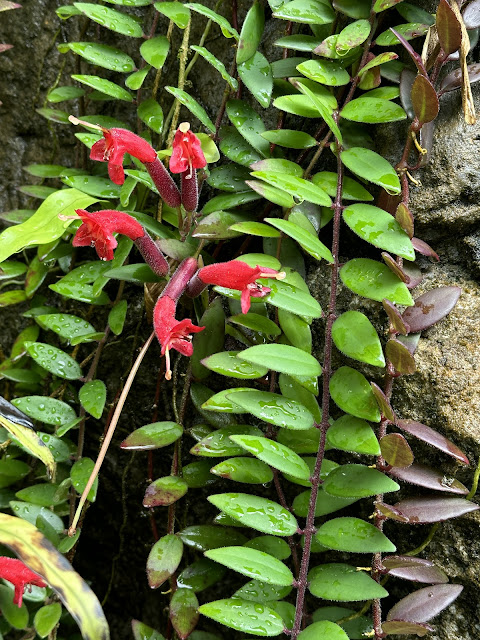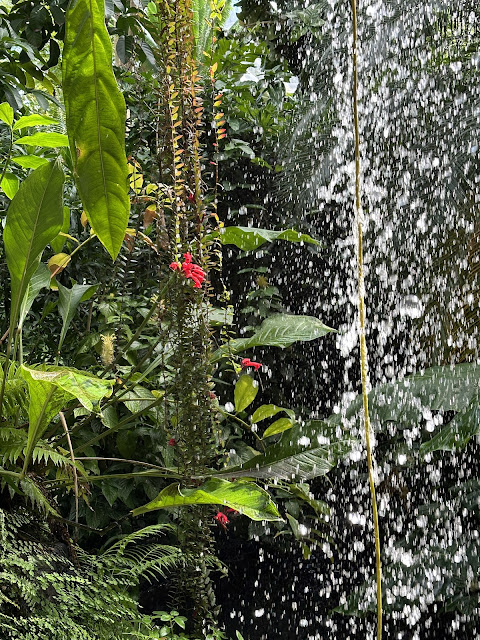One of the field trips during the Gesneriad Society convention in July was a visit to the Missouri Botanical Garden, including a tour through the Climatron. Josh Higgins, a garden employee and gesneriad enthusiast gave us a tour during which he pointed out the many gesneriads hiding among the plants throughout the glasshouse.
 |
| The Climatron |
Moussonia deppeana was the first gesneriad spotted. The small shrub is found from Mexico to Guatemala. The attractive foliage tinted by red hairs stood out amount the greenery. Alas, no blooms were seen.
 |
Mousonnia deppeana
|
I spotted Drymonia chiribogana from a distance. The large distinctively-veined leaves make it easy to see. This Ecuadorian native is easy to grow. Depsited developing into a tall plant, it blooms easily under lights. I find the bloom trend to be at the base of the planet so it can be kept manageable with pruning.
 |
Drymonia chiribogana
|
Flowering plants of
Primulina tatiana were seen growing in the understory at several locations. I know from experience the species is self-pollinating, and seedlings will frequently pop up in nearby pots on my light stand. I would suspect the plant will spread the same way in the botanical garden. It's easy to grow under lights and is popular with collectors.
 |
| Primulina tamiana |
Sinningia iarae was spotted in several places in the Climatron. The plant attracted my attention as I have seedlings of this species started at home and am anxiously awaiting the blooms. Mauro Peixoto, who was on the tour with us, is credited with introducing this Brazilian species into cultivation.
 |
| Sinningia iarae |
An
Aslobia was spotted growing on wet moss-covered rock surfaces. The genus is native to Mexico, Guatemala, and Costa Rica. I didn't notice a plant label to learn the specific species or hybrid. This is a fun, trailing species which grows well under lights or in a window. The large white blooms are an attractive addition to the beautiful, somewhat succulent, foliage.
 |
| Alsobia |
This trailing
Aeschynanthus was seen in numerous locations throughout the Climatron. It could be seen hanging from tree branches, on rock faces, as well as hanging freely near a waterfall.
 |
Aeschynanthus
|
 |
| Aeschynanthus and falling water |
The shrub-like
Gesneria pedunculosa was spotted in several places. This South American native sports yellow flowers, in contrast to the yellow and orange blooms of other
Gesneria species. Alas it was not in flower currently but the glossy foliage is very attractive.
 |
| Gesneria pedunculosa |
Kohleria tubiflora with its bronze leaves made a dramatic showing amongst the foliage jungle.
K. tubiflora is one of my
favorite "weeds" at home.
 |
| Kohleria tubiflora |
Some of the Kohleria tubiflora were sporting the attractive orange blooms. Found throughout the southern part to Central America and northern South America, the plant is a tall, wild growing shrub. It blooms readily, even from small, freshly rooted cuttings.
 |
| Kohleria tubiflora in bloom |
Our group included two experienced field botanists as well. Following Alain Chautems and Mauro Peixoto past cascading waterfalls with red Aescynanthus blooms sparkling in the sunlight made it almost seem like a real rainforest expedition.
There were of course many other interesting plants to see in the Climatron, and throughout the botanical gardens. Combined with the pleasant weather, it made for an exciting and most enjoyable morning.











Comments
Post a Comment